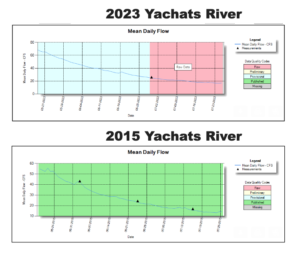
By QUINTON SMITH and GARRET JAROS/YachatsNews
After three months of almost no rain and the likelihood of little more until October, Lincoln County commissioners Wednesday asked Gov. Tina Kotek to declare a drought emergency for all of the county.
The last time such a declaration was made was in 2021.
The central coast has had record-low rainfall in May, June and July. Commissioners were told Wednesday that Oregon Department of Forestry weather forecasters see little rain falling in August and September.
The request for the emergency declaration came about via an ad-hoc drought committee convened in June by commissioner Kaety Jacobson. A member of that committee, Alan Fujisin of Gibson Farms in Siletz, wrote a four-page memo to commissioners saying that prolonged dry weather is affecting crops, wells are at September levels, and that irrigators with secondary rights to the heavily-used Siletz River are expected to be cut off this week.
“… the lack of meaningful precipitation in the forecast, the dry three-month projection for coastal Oregon, both suggest that drought conditions are going to get much worse before they get better,” Fujisin wrote.
Already, rivers in Lincoln County are seeing the effects of little rain since May. Fujisin said the Siletz River at the community of Siletz is running at 46 percent of average, the Alsea River is 70 percent of average and the Yachats River at 66 percent of average for the end of July.
The emergency drought declaration allows the county to ask state water and emergency managers for technical assistance or financial aid if the county cannot provide it, said Brian Gardner, assistant county counsel. That also applies for restricting water use in local rivers, he said.
The commissioners’ resolution also called on the Mid-Coast Conservation Consortium and other public and private water suppliers in the county “to begin water conservation education and specific curtailment activities as appropriate to address the current drought conditions …”
Watching water supply
The lack of rain and low river flows is already very visible in the Yachats area.

“It’s abnormal,” said Yachats water plant operator Rick McClung. “It’s almost as low as our 2015 drought. We didn’t really get rain in May, June, July and most the time we get rain at least until June.”
McClung notified city officials last week that “flows are dropping at a steady rate” with Reedy and Salmon creeks at a combined 345 gallons per minute. In accordance with city code, once those creek flows drop to 275 gallons a minute, phase I water restrictions kick in – which means in part that watering lawns and gardens must be done on alternating days depending on odd-even addresses.
With no rain in the forecast, McClung estimates it will be a couple of weeks before the flow drops the 70 gallons per minute that will push Yachats into phase I.
“Phases I and II aren’t so bad,” McClung said. “Three is pretty bad because it shuts down the hotel laundry ability.”
Yachats barely avoided phase III in 2015.
Dry July, June and May
Weather watchers who provide YachatsNews with monthly data have been recording record-low precipitation amounts since May.

While Yachats historically gets a half-inch of rain in July, precipitation this July was one-fifth of that. The three-month average for May, June and July at the Yachats water treatment plant is 6.41 inches of rain.
The city measured .10 inches of rain at the plant in July and just .81 inches for the last three months.
Adam Altson, who lives near the treatment plant, had similar totals for July and the three-month period “easily my lowest total for those three months, although I only have six years of rainfall data.”
Donald Tucker, who lives two miles north of Yachats, recorded .10 inches of rain in July, .81 inches for the last three months and has 36.40 inches for the year.
It’s no different up the Yachats River.
Jim Adler, who lives three miles up river, measured .08 inches in July and has .95 inches for the last three months, and 47.59 for the year.
“I’ve had four drier July’s in my 15 year record — 2013, 2017, 2018, and 2020 all had no rain at all,” he said.
Bob Williams, who lives eight miles upriver, had .04 inches of rain in July, .83 inches for the last three months and 60.87 for the year.
“My unscientific observation is there has been very little overcast, fog, or drizzle since early May with most days sunny and in the 80’s,” he said. “Grass in the sun is crispy brown, and the river is as low as I’ve seen it over the past five years.”
In addition to rain, elevation apparently matters when it comes to temperature.
Julie Bailey, who lives at the 220-foot level on Radar Road in Yachats, recorded 21 days of temperatures 70 degrees or more in July, with nine of those days 74 degrees or higher.
While the area may suffer with little to no rain until October, Williams offered this observation for the late fall and winter.
“We’ve been told that this is an El Nino year where we can expect above normal rainfall toward the end of the year,” Williams said. “Our last El Nino year was 2015 where I recorded 32.08 inches in December.”



